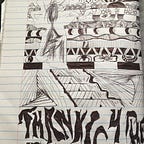On page 580 of Psychology Frontiers and Applications, at the bottom under the PTSD section, it mentions that for most Indigenous children who attended a residential school, there was no lasting impact other than what is experienced by many children who attend a boarding school for an extended period of time. It continues to say that for a significant minority of residential school students, however, there were lasting problems. To me, while I am sure there are many reasons for why this ended up in the book, it looks a little bit like denial. Whether it is or not, I can guarantee you that this is not true.
I did some further research on the impact of residential schools. First, given the events occurring in the country this past spring and summer, I have to say that I believe murder would be considered a lasting impact. In September of 2021, CBC released an article I won’t name (simply because reading it aloud makes me sick to my stomach) regarding the bodies of Indigenous children that have been, and are continuing to be, found across this country at the sites of these buildings. The article talks about the National Centre for Truth and Reconciliation, who has access to the Truth and Reconciliation Commission’s records, and up until this point — this is months ago — they had found four thousand, one hundred and eighteen records of children.
Dead children.
Children who once had dreams, hopes.
Children that should have been able to sit in classes like these, but instead had that taken from them.
The Centre further stated that this was only after going through one fifth of these records.
They believe that this number will increase five times over.
That would be about twenty thousand, five hundred and ninety children.
Given that about one hundred and fifty thousand children attended residential schools in this country, that’s about fourteen percent.
These schools were mandatory. In 1920 under the Indian Act it was declared mandatory for an Indigenous child to attend, and illegal for them to attend any other institution of education — parents had no choice but to send their kids away.
This is because originally, in 1620 when French settlers first wrongfully declared this land theirs and their missionaries set up what were back then known as “boarding” schools for Indigenous children, they didn’t want to send their kids. The children would run home or find excuses for why they couldn’t attend.
So we forced them.
It was ILLEGAL for children to speak their languages with each other at this school. Children did not have a sense of personal autonomy. Their hair, a spiritual part of many Indigenous children’s identities, was shaven off. They were forbidden with communicating with relatives that attended school with them. Siblings who were of different genders (and thus attended different schools) were not allowed to communicate. Their NAMES were stripped from them and were replaced with European names.
I’m curious to know what other boarding schools have a death toll that high.
I’m curious to know what other boarding schools cut their childrens’ hair. I’ve heard tell of that happening to Black children when they wear their hair in a way deemed “unprofessional” by white people. In fact, I’ve heard of that happening to Black children in South Africa.
I’m curious to know what boarding schools take their students’ names from them.
What boarding schools steal their students’ personal belongings with no repercussions.
What boarding schools prohibit their students from communicating with their families and relatives. What boarding schools prohibit their students from speaking freely amongst one another.
The children of people who dealt with this were my peers and friends in high school. They are my friends to this day. These are the people whose land you go onto for cheaper fuel, especially with the rising gas prices we’ve been seeing for the past few months. These are people. And these people are real and valid. Their stress colours their everyday life so fully we cannot claim to understand how it does and does not affect them. Their stories largely go untold. Who are we to claim we understand what we’ve done? We’re barely one generation removed from this pain. You can feel it in the air when you step onto a reservation.
You can feel it when you see the silence reflected in your classmates’ faces when the teacher asks you all, “How do you think colonialism impacted Indigenous people across Canada?” and everyone falls silent. They know all too well. They’ll see it again when they go home.
If you don’t see, you’re not looking hard enough. If you can’t see, I promise you, it’s because of your refusal to accept reality.
